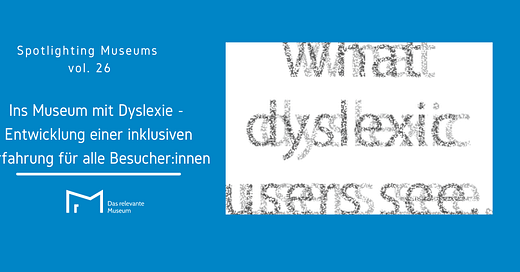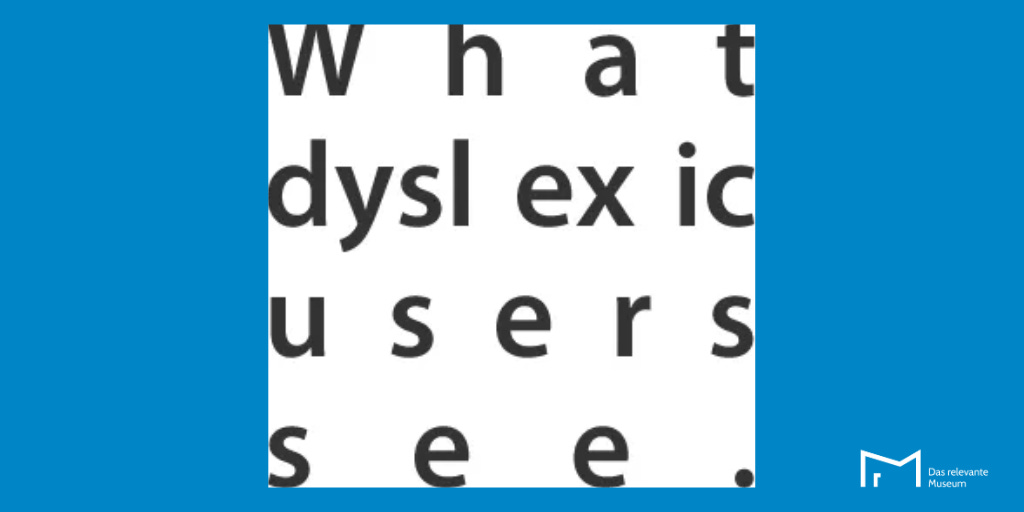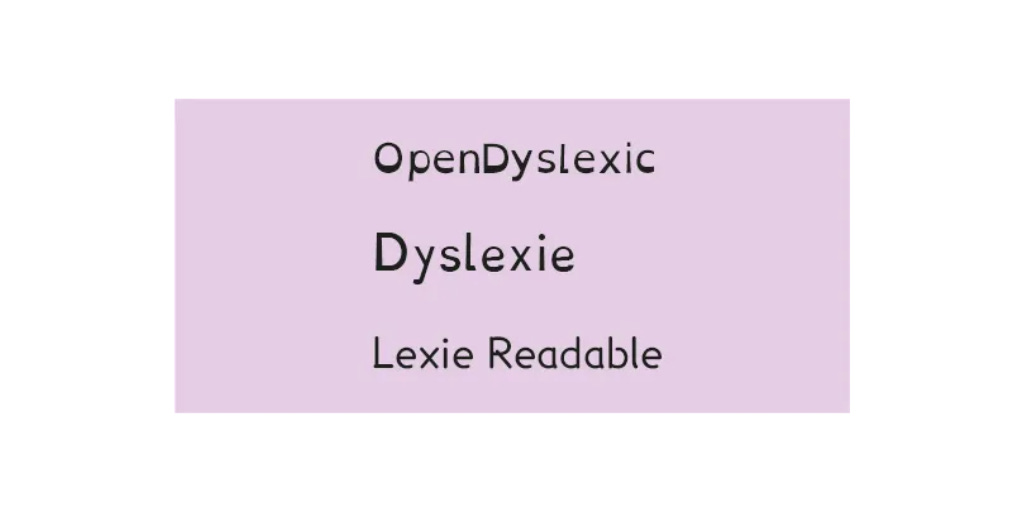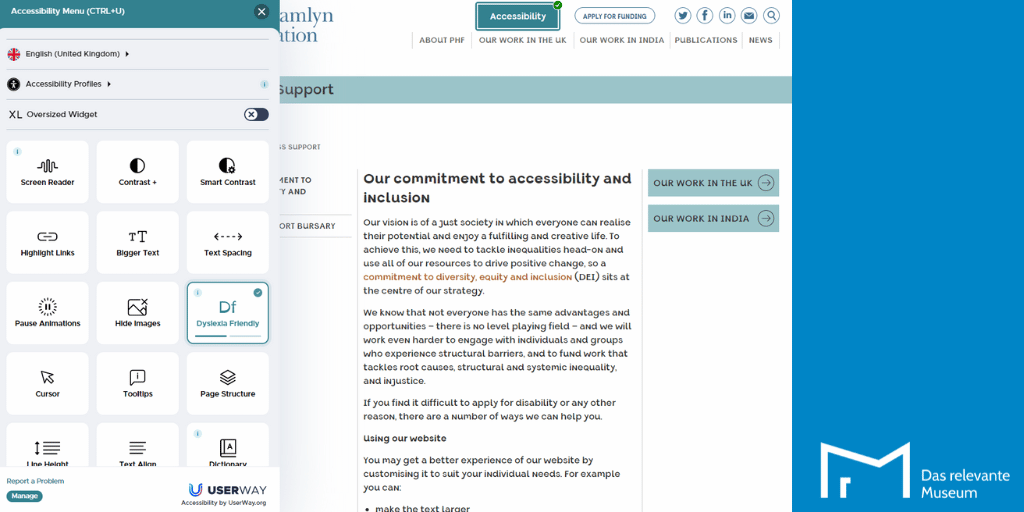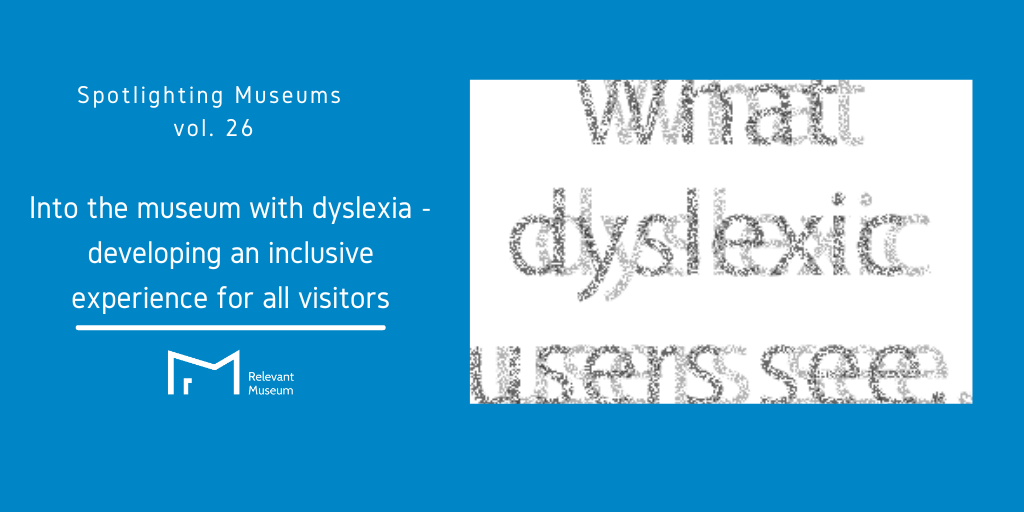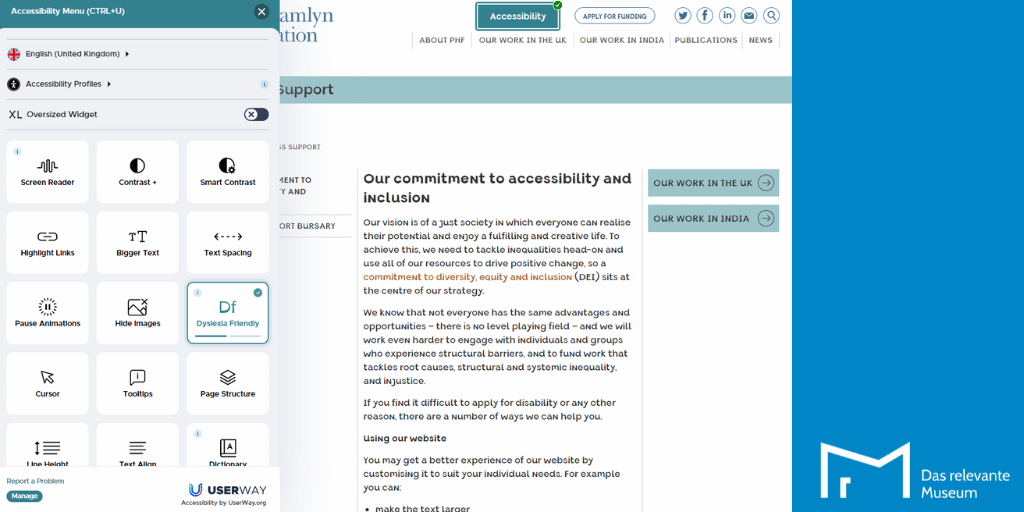Spotlighting Museums, vol. 26
Ins Museum mit Dyslexie - Entwicklung einer inklusiven Erfahrung für alle Besucher:innen
Please find the English Version below
Dyslexiefreundlicher Newsletter
Liebe Leser:innen, willkommen zur Mai-Ausgabe von Spotlighting Museums zum Thema Museumsbesuche von Menschen mit Dyslexie!
In dieser Ausgabe möchten wir Ihnen Informationen und Ressourcen bieten, um das Verständnis für Dyslexie im Allgemeinen und besonders in musealen Umgebungen zu fördern und Wege aufzeigen, wie Museen dyslexiefreundlicher gestaltet werden können. Anna Leshchenko – sie ist Museologin, wissenschaftliche Mitarbeiterin und Doktorandin an der Universität Tübingen – lebt mit Dyslexie und hat sich bereit erklärt, offen über ihre Erfahrungen und Strategien im Umgang mit Dyslexie zu sprechen.
Dyslexie verstehen
Eine grobe Einordnung: Dyslexie und Legasthenie beschreiben eine Lese- und Rechtschreibstörung. Im deutschsprachigen Raum werden die beiden Begriffe oft synonym verwendet. Dyslexie bezieht sich auf eine spezifische Lese-Rechtschreib-Störung, die auf neurologischen und genetischen Faktoren beruht. Menschen mit Dyslexie haben Schwierigkeiten beim Erkennen und Verbinden von Buchstaben, beim Zuordnen von Lauten zu Buchstaben und beim korrekten Lesen und Schreiben von Wörtern. Diese Schwierigkeiten treten unabhängig von Intelligenz oder Bildungsniveau auf und sind auf Unterschiede in der Verarbeitung von sprachlichen Informationen im Gehirn zurückzuführen. Dyslexie kann sich auf verschiedene Aspekte des Lese- und Schreibprozesses auswirken und unterschiedliche Symptome und Schweregrade haben.
Wie viele Menschen leben mit Dyslexie?
Je nach Studie und Diagnosekriterien variiert die Anzahl der Menschen mit Dyslexie stark. Schätzungen zufolge sind etwa fünf bis zehn Prozent der Bevölkerung davon betroffen. Da nicht alle Betroffenen diagnostiziert oder erkannt werden, geht man von einer gewissen Dunkelziffer aus.
Inklusivere Museen, aber noch zu wenig Fokus auf Dyslexie
In der aktuellen Debatte zu inklusiveren Kulturinstitutionen werden die Bedürfnisse neurodiverser Menschen immer mehr mit einbezogen. Es fällt aber auf, so Anna, "[...] dass der Fokus [mehr] auf den Herausforderungen im Zusammenhang mit dem Autismus-Spektrum [liegt] und nicht auf den Dyslexie-Schwierigkeiten. Und damit meine ich nicht nur die Situation in deutschsprachigen Ländern."
Texte lesen als Herausforderung
Anna beschreibt, wie sie einen gedruckten Text wahrnimmt:
“[...] in der Regel [sehe ich] ein Wort deutlich, während die anderen Wörter drumherum vager sind. Ich kann zum Beispiel nicht über die Texte hinwegfliegen und Ihnen sagen, worum es geht, ich muss den gesamten Text lesen – jedes Wort – um es zu verstehen, oft muss ich zweimal lesen. Ich habe das Gefühl, dass die erste Runde dazu dient, die "verschlüsselten Hieroglyphen" zu erkennen, und in der zweiten Runde ist der Text schon einfacher zu verstehen, weil ich bereits weiß, welche Wörter ich erwarten kann. Bei einigen gedruckten, dicht gesetzten Textlayouts kann ich nicht mehr als zwei Absätze lesen, ohne müde zu werden.”

Anna: “Wenn ich versuche, alle Texte in der Ausstellung eines Museums zu lesen, werde ich sehr schnell müde. Wenn ich dann merke, dass die Texte nicht lesbar für mich sind, mache ich in der Regel Fotos von den Texten, die mich interessieren, um sie später zu lesen, und konzentriere mich auf die Objekte. Und um ehrlich zu sein: Ich habe Hunderte von Fotos auf meinem Handy, von denen ich die Texte nicht erneut gelesen habe, weil die Objekte oder der Kontext nicht mehr vorhanden waren. Ich würde es bevorzugen, die meisten Informationen direkt im Museum zu erhalten.”
Wie bestimmte Schriften helfen können
Um Menschen mit Dyslexie das Lesen zu erleichtern, gibt es Schriftarten, die als "dyslexiefreundlich" gelten. Diese verwenden bestimmte Merkmale, um besser zwischen Buchstaben zu unterscheiden und Verwechslungen zu reduzieren. Ein paar Beispiele:
Kosten: Es ist möglich selbst einen fairen Preis zu bestimmen.
Kosten: Es wird zwischen den Nutzer:innen (Privat, Business, Bildung u.a.) unterschieden. Einmaliger Preis zwischen Euro 80 bis 150.
Kosten: Es wird nach Anwendung (Desktop, Web, App, digitale Anzeigen, elektronische Dokumente, Server) unterschieden. Preis zwischen Euro 18 bis 40 pro Schrift.
Aber auch serifenlose Schriftarten wie Arial, Verdana oder Open Sans sind oft besser lesbar, als Schriftarten mit verschnörkelten oder ungewöhnlichen Buchstabenformen, oder mit zu dünnen oder zu fetten Linien.
Dank der speziell gestalteten Schriftart “Dyslexie” kann Anna “[...] viel mehr lesen [kann], ohne erschöpft zu werden, und [muss] nicht mehr erneut lesen. [...] Von allen dyslexiefreundlichen Schriftarten ist nur "Dyslexie" in der Lage, die visuellen Hindernisse zu überwinden, die ich mit anderen Schriftarten erlebe.” Ausserdem unterstützen Aufnahmen von Texten, die von professionellen Sprecher:innen mit Emotionen und Pausen laut vorgelesen werden, das Lesen zusätzlich.
Hilfestellungen für dyslexiefreundliche Kommunikation
Diese praktischen Tipps können helfen, das Museumserlebnis für Menschen mit Dyslexie angenehmer und zugänglicher zu machen:
Webseite: Bieten Sie wenn möglich Optionen an, um den Text individuell anpassen zu können, wie das Ändern von Zeilen- und Wortabständen, oder das Anpassen der Schriftarten auf Schriftarten ohne Serifen. Ein Beispiel: Paul Hamlyn Foundation (phf.org.uk)
Wandtexte / Saaltexte: Es gibt verschiedene Tools, die beim Lesen helfen (Speak Selection; Google Translate u.a.). Tipp: Versehen Sie die Texte zusätzlich mit einem QR-Code, um ihn auf das eigene Smartphone zu laden und individuell anzupassen.
Visuelle Elemente betonen: Ergänzen Sie schriftliche Informationen mit visuellen Elementen wie Bildern, Diagrammen und Grafiken, um die Bedeutung visueller Reize zu betonen und den Informationsfluss zu erleichtern.
Klare und einfache Sprache verwenden, um komplexe Informationen verständlich zu vermitteln. Vermeiden Sie übermäßig lange Sätze und Fachbegriffe.
Alternative Formate anbieten wie zum Beispiel Audioguides oder Videos, um den Zugang zu Informationen zu erleichtern.
Arbeitskreis für mehr Dyslexieprojekte in Museen
Um Museen stärker für das Thema Dyslexie zu sensibilisieren, sie in Dyslexieprojekten zu unterstützen und die Entwicklung geeigneter Tools für Besucher:innen mit Dyslexie in Museen zu fördern, hat Anna den Arbeitskreis “Dyslexie” gegründet. Mittlerweile gehören ihm zehn Personen an. Sie sammeln Erfahrungen aus anderen Ländern und untersuchen, wie Besucher:innen mit Dyslexie optimal geholfen werden kann. Weiter möchten sie ein Tool für bestehende Apps und Webseiten entwickeln, um flexibel zu bleiben und sich an die Bedürfnisse von Menschen mit Dyslexie anzupassen. Sobald die Finanzierung des Projektvorhabens gesichert ist und Museen und andere Interessensgruppen ihr Interesse bekunden, starten sie mit der Entwicklung.
Kennen Sie spannende Projekte oder Lösungsansätze, die Menschen mit Dyslexie den Museumsbesuch erleichtern? Dann senden Sie den Link zum Projekt oder einen Hinweis dazu an anna.leshchenko[at]uni-tuebingen.de.
Vielen Dank, Anna, für deine Bereitschaft, über deine Erfahrungen zu sprechen. Deine Perspektive wird sicherlich vielen Menschen helfen, Dyslexie besser zu verstehen und sensibler darauf einzugehen.
Als freie Kunst- und Kulturvermittlerin liegt mir die Sensibilisierung für Dyslexie am Herzen, so entstand dieser Text in Zusammenarbeit mit dem Programm “Das relevante Museum”. Als Mitarbeitende in der Förderung der Stiftung für Kunst, Kultur und Geschichte (SKKG) arbeite ich an Projekten, die sich für mehr Partizipation im materiellen Kulturerbe einsetzen.
Herzliche Grüße,
Christine Müller Stalder
Weiterführende Links:
Die Stiftung "Zugang für alle" ist das Kompetenzzentrum und Schweizer Zertifizierungsstelle für digitale Barrierefreiheit.
Fachstelle Kultur inklusiv - Kultur inklusiv
Die Fachstelle Kultur inklusiv von Pro Infirmis ist das Kompetenzzentrum für inklusive Kultur in der Schweiz.
Dyslexia Typeface - Daniel Britton
Daniel Britton ist Designer und lebt mit Dyslexie. Er hat eine Schrift entworfen, um damit Menschen ohne Dyslexie das Lesen mit Dyslexie nachempfinden können.
Bundesverband Legasthenie & Dyskalkulie e.V.
English Version
Spotlighting Museums, vol. 26
Into the museum with dyslexia - developing an inclusive experience for all visitors
Dyslexia-friendly newsletter
Dear readers, welcome to the May issue of Spotlighting Museums on the topic of museum visits by people with dyslexia!
In this issue, we aim to provide you with information and resources to promote understanding of dyslexia in general and in museum settings in particular, as well as ways to make museums more dyslexia-friendly. Anna Leshchenko - she is a museologist, research assistant and PhD student at the University of Tübingen - lives with dyslexia and has agreed to talk openly about her experiences and strategies for dealing with dyslexia.
Understanding dyslexia
A brief introduction: Dyslexia and “Legasthenie” [in german] describe a reading and spelling disorder. In German-speaking countries, the two terms are often used synonymously. Dyslexia refers to a specific reading and spelling disorder based on neurological and genetic factors. People with dyslexia have difficulty recognising and connecting letters, matching sounds to letters, and reading and writing words correctly. These difficulties occur regardless of intelligence or educational level and are due to differences in how the brain processes linguistic information. Dyslexia can affect different aspects of the reading and writing process and have different symptoms and levels of severity.
How many people live with dyslexia?
Depending on the study and diagnostic criteria, the number of people with dyslexia varies significantly. It is estimated that about five to ten percent of the population is affected. Since not all affected people are diagnosed or recognised, it is assumed that there is a certain number of unreported cases.
More inclusive museums, but still too little focus on dyslexia
In the current debate on more inclusive cultural institutions, the needs of neurodiverse people are increasingly included. However, according to Anna, it is noticeable, that "[...] the focus is on the issues linked to autism spectrum condition [and] not on dyslexia difficulties. And I don't just mean the situation in German-speaking countries."
Reading texts as a challenge
Anna describes how she perceives a printed text:
"[...] I usually see one word clearly, while the other words around it are vaguer. I can’t, for example, skim through the texts and tell you what it's about, I have to read the whole text – each word – to understand, I often have to read twice. It feels like the first round is to “recognize” the coded hieroglyphics and in the second round the text is already easier to understand because I already know which words to expect. In some printed, densely set text layouts, I’m not able to read more than two paragraphs without getting tired."
Anna: "If I try to read all the texts that are in the exhibition, I get tired very soon and, when I notice that the texts are not readable, I usually take photos of labels that interest me to read them later and focus on the objects. And to be honest: I have hundreds of photos on my phone that I have not re-read because the objects or context was not there anymore. I would prefer to get most of the information right in the museum.”
How certain fonts can help
To make reading easier for people with dyslexia, there are fonts that are considered "dyslexia-friendly". These use certain features to better distinguish between letters and reduce confusion. A few examples:
Pricing: A fair price can be suggested.
Pricing: A distinction is made between users (private, business, education, etc.). Life-time price between Euro 80 to 150.
Pricing: A distinction is made according to the application (Desktop, Web, App, Digital Ads, Electronic Docs, Server). Price between Euro 18 to 40 per font.
But fonts such as Arial, Verdana or Open Sans are also often easier to read than fonts with squiggly or unusual letter shapes, or with lines that are too thin or too bold.
Thanks to the specially designed font "Dyslexie", Anna "[...] can read a lot more without getting exhausted and do not have to re-read anymore. [...] Of all the dyslexia-friendly fonts, only "Dyslexie" stops the visual obstacles that I am experiencing with other fonts." In addition, recordings of texts read aloud by professional speakers with emotions and pauses further support reading.
Aids for dyslexia-friendly communication
These practical tips can help make the museum experience more enjoyable and accessible for people with dyslexia:
Website: if possible, offer options to customize the text, such as changing line and word spacing or adjusting fonts to non-serif. An example: Paul Hamlyn Foundation (phf.org.uk)
Wall texts / hall texts: There are various tools that help with reading (Speak Selection; Google Translate, etc.). Tip: Provide the texts additionally with a QR code to download it to your own smartphone and adapt it individually.
Emphasize visual elements: Supplement written information with visual elements such as pictures, diagrams and graphics to emphasize the importance of visual stimuli and facilitate the flow of information.
Use clear and simple language to convey complex information in an understandable way. Avoid excessively long sentences and technical terms.
Offer alternative formats such as audio guides or videos to facilitate access to information.
Working group for more dyslexia projects in museums
In order to make museums more aware of the issue of dyslexia, to support them in dyslexia projects and to promote the development of suitable tools for visitors with dyslexia in museums, Anna has founded the working group "Dyslexia". It now has ten members. They are gathering experiences from other countries and investigating how best to help visitors with dyslexia. They also want to develop a tool for existing apps and websites to remain flexible and adapt to the needs of people with dyslexia. As soon as the funding for the project is secured and museums and other interest groups express their interest, they will start with the development.
Do you know of any exciting projects or solutions that make it easier for people with dyslexia to visit museums? Then send the link to the project or a note about it to anna.leshchenko[at]uni-tuebingen.de.
Thank you, Anna, for your willingness to talk about your experiences. Your perspective will certainly help many people to better understand and be more sensitive to dyslexia.
As a freelance arts and culture educator, dyslexia it means a lot to me, so this text was written in collaboration with the programme "The Relevant Museum". As an employee in the promotion of the Stiftung für Kunst, Kultur und Geschichte (SKKG), I work on projects that advocate for more participation in material cultural heritage.
Best wishes
Christine Müller Stalder
Further Links:
The "Access for All" Foundation is the competence centre and Swiss certification body for digital accessibility.
Fachstelle Kultur inklusiv - Kultur inklusiv
Pro Infirmis' specialist office for inclusive culture is the centre of competence for inclusive culture in Switzerland.
Dyslexia Typeface - Daniel Britton
Daniel Britton is a designer living with dyslexia. He has designed a font so that people without dyslexia can recreate reading with dyslexia.
